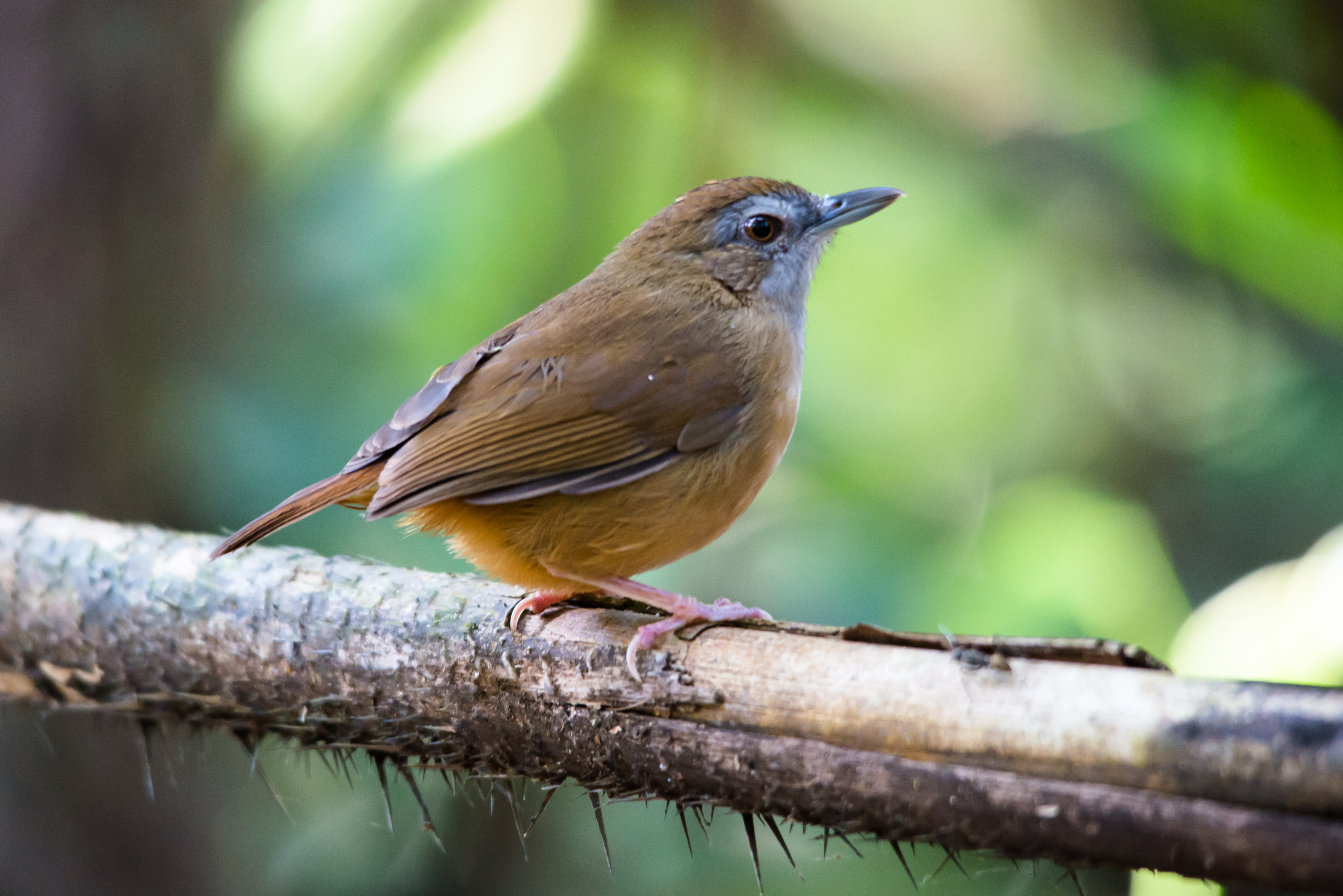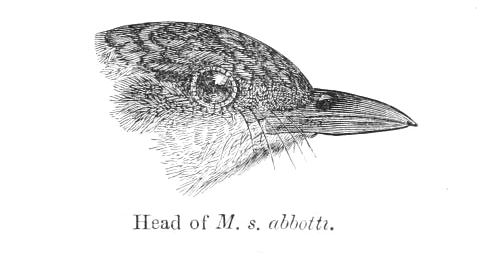|
Malacocincla
''Malacocincla'' is a genus of passerine birds in the family Pellorneidae The jungle babblers are a family, Pellorneidae, of mostly Old World passerine birds belonging to the superfamily Sylvioidea. They are quite diverse in size and coloration, and usually characterised by soft, fluffy plumage and a tail on average th .... The type species for this genus is ''M. abbotti'', and a 2012 study shows that members of the genus ''Malacocincla'' as defined earlier fall into multiple clades and are therefore polyphyletic. ''M. abbotti'' and ''M. sepiaria'' remain within a common clade and could be retained in the genus if generic reassignments occur. This clade is a sister of the genus ''Napothera''. ''M. cinereiceps'' and ''M. malaccensis'' fall into a different clade and are a sister to the genus ''Trichastoma'' and nested within several species of ''Pellorneum''. The position of ''M. perspicillata'' has not been resolved. Species The genus contains the following species: References ... [...More Info...] [...Related Items...] OR: [Wikipedia] [Google] [Baidu] |
Abbott's Babbler
Abbott's babbler (''Malacocincla abbotti'') is a species of bird in the family Pellorneidae. It is widely distributed along the Himalayas in South Asia and extending into the forests of Southeast Asia. They are short-tailed and stout birds which forage in pairs in dense undergrowth close to the ground and their presence is indicated by their distinctive calls. Taxonomy Abbott's babbler was described by the English zoologist Edward Blyth in 1845 and given the binomial name ''Malacocincla abbotti''. The genus name ''Malacocincla'' combines the Ancient Greek ''malakos'' meaning "soft" with modern Latin ''cinclus'', meaning " thrush"; referring to the birds' full and drooping plumage. The specific name ''abbotti'' was chosen by Blyth to honour the specimen collector, Lieutenant Colonel J. R. Abbott (1811–1888), who served in British India as Assistant Commissioner of the Arakan from 1837 to 1845. Blyth erected the new genus ''Malacocincla'' for this species, but subsequent workers ... [...More Info...] [...Related Items...] OR: [Wikipedia] [Google] [Baidu] |
Malacocincla
''Malacocincla'' is a genus of passerine birds in the family Pellorneidae The jungle babblers are a family, Pellorneidae, of mostly Old World passerine birds belonging to the superfamily Sylvioidea. They are quite diverse in size and coloration, and usually characterised by soft, fluffy plumage and a tail on average th .... The type species for this genus is ''M. abbotti'', and a 2012 study shows that members of the genus ''Malacocincla'' as defined earlier fall into multiple clades and are therefore polyphyletic. ''M. abbotti'' and ''M. sepiaria'' remain within a common clade and could be retained in the genus if generic reassignments occur. This clade is a sister of the genus ''Napothera''. ''M. cinereiceps'' and ''M. malaccensis'' fall into a different clade and are a sister to the genus ''Trichastoma'' and nested within several species of ''Pellorneum''. The position of ''M. perspicillata'' has not been resolved. Species The genus contains the following species: References ... [...More Info...] [...Related Items...] OR: [Wikipedia] [Google] [Baidu] |
Black-browed Babbler
The black-browed babbler (''Malacocincla perspicillata'') is a songbird species in the family Pellorneidae. The species is endemic to Borneo. Only a single specimen collected in the nineteenth century was known, until the species was rediscovered in Borneo in 2020. Habitat The natural habitat of ''M. perspicillata'' is subtropical or tropical moist lowland forests, at altitudes of . Its rediscovery in 2020 confirmed that the bird is from southeast Borneo. Conservation status The conservation status of ''M. perspicillata'' is insufficiently known. It was formerly classified as Vulnerable by the IUCN, but due to the lack of information surrounding the species, its status was changed to Data Deficient in 2008. The songbird is threatened by agriculture, logging allowed within protected areas, plantations for rubber and palm oil, and drought fires. Within the next few years, there is risk of near complete loss of dryland lowland forest in Kalimantan. Rediscovery In October 2020, ' ... [...More Info...] [...Related Items...] OR: [Wikipedia] [Google] [Baidu] |
Pellorneidae
The jungle babblers are a family, Pellorneidae, of mostly Old World passerine birds belonging to the superfamily Sylvioidea. They are quite diverse in size and coloration, and usually characterised by soft, fluffy plumage and a tail on average the length of their body, or longer. These birds are found in tropical zones, with the greatest biodiversity in Southeast Asia and the Indian subcontinent. Morphological diversity is rather high; most species resemble warblers, jays or thrushes, making field identification difficult. The family Pellorneidae was first introduced by the French-American ornithologist Jean Théodore Delacour in 1946. Pellorneidae used to be one of four subfamilies of Timaliidae (tree- and scimitar-babblers), but was then elevated to its own family rank in 2011 based on molecular markers. Description Jungle babblers are small to medium-sized birds which are on average 14 cm long and weigh around 30g, but range from 10–26 cm, and 12-36g Divid ... [...More Info...] [...Related Items...] OR: [Wikipedia] [Google] [Baidu] |
Horsfield's Babbler (cropped)
Horsfield's babbler (''Malacocincla sepiaria'') is a species of bird in the family Pellorneidae. It is found in Brunei, Indonesia, Malaysia, and Thailand. Its natural habitats are subtropical or tropical moist lowland forest and subtropical or tropical moist montane forest. The common name commemorates the American naturalist Thomas Horsfield. References *Collar, N. J. & Robson, C. 2007. Family Timaliidae (Babblers) pp. 70 – 291 in; del Hoyo, J., Elliott, A. & Christie, D.A. eds. ''Handbook of the Birds of the World The ''Handbook of the Birds of the World'' (HBW) is a multi-volume series produced by the Spanish publishing house Lynx Edicions in partnership with BirdLife International. It is the first handbook to cover every known living species of bird. T ...'', Vol. 12. Picathartes to Tits and Chickadees. Lynx Edicions, Barcelona. {{Taxonbar, from=Q73865 Horsfield's babbler Birds of Malesia Horsfield's babbler Taxonomy articles created by Polbot ... [...More Info...] [...Related Items...] OR: [Wikipedia] [Google] [Baidu] |
Horsfield's Babbler
Horsfield's babbler (''Malacocincla sepiaria'') is a species of bird in the family Pellorneidae. It is found in Brunei, Indonesia, Malaysia, and Thailand. Its natural habitats are subtropical or tropical moist lowland forest and subtropical or tropical moist montane forest. The common name commemorates the American naturalist Thomas Horsfield. References *Collar, N. J. & Robson, C. 2007. Family Timaliidae (Babblers) pp. 70 – 291 in; del Hoyo, J., Elliott, A. & Christie, D.A. eds. ''Handbook of the Birds of the World The ''Handbook of the Birds of the World'' (HBW) is a multi-volume series produced by the Spanish publishing house Lynx Edicions in partnership with BirdLife International. It is the first handbook to cover every known living species of bird. T ...'', Vol. 12. Picathartes to Tits and Chickadees. Lynx Edicions, Barcelona. {{Taxonbar, from=Q73865 Horsfield's babbler Birds of Malesia Horsfield's babbler Taxonomy articles created by Polbot ... [...More Info...] [...Related Items...] OR: [Wikipedia] [Google] [Baidu] |
Edward Blyth
Edward Blyth (23 December 1810 – 27 December 1873) was an English zoologist who worked for most of his life in India as a curator of zoology at the museum of the Asiatic Society of India in Calcutta. Blyth was born in London in 1810. In 1841 he travelled to India to become the curator of the museum of the Royal Asiatic Society of Bengal. He set about updating the museum's catalogues, publishing a ''Catalogue of the Birds of the Asiatic Society'' in 1849. He was prevented from doing much fieldwork himself, but received and described bird specimens from A.O. Hume, Samuel Tickell, Robert Swinhoe and others. He remained as curator until 1862, when ill-health forced his return to England. His ''Natural History of the Cranes'' was published posthumously in 1881. Avian species bearing his name include Blyth's hornbill, Blyth's leaf warbler, Blyth's hawk-eagle, Blyth's olive bulbul, Blyth's parakeet, Blyth's frogmouth, Blyth's reed warbler, Blyth's rosefinch, Blyth's shrike-babbl ... [...More Info...] [...Related Items...] OR: [Wikipedia] [Google] [Baidu] |
Genus
Genus ( plural genera ) is a taxonomic rank used in the biological classification of extant taxon, living and fossil organisms as well as Virus classification#ICTV classification, viruses. In the hierarchy of biological classification, genus comes above species and below family (taxonomy), family. In binomial nomenclature, the genus name forms the first part of the binomial species name for each species within the genus. :E.g. ''Panthera leo'' (lion) and ''Panthera onca'' (jaguar) are two species within the genus ''Panthera''. ''Panthera'' is a genus within the family Felidae. The composition of a genus is determined by taxonomy (biology), taxonomists. The standards for genus classification are not strictly codified, so different authorities often produce different classifications for genera. There are some general practices used, however, including the idea that a newly defined genus should fulfill these three criteria to be descriptively useful: # monophyly – all descendants ... [...More Info...] [...Related Items...] OR: [Wikipedia] [Google] [Baidu] |
Passerine
A passerine () is any bird of the order Passeriformes (; from Latin 'sparrow' and '-shaped'), which includes more than half of all bird species. Sometimes known as perching birds, passerines are distinguished from other orders of birds by the arrangement of their toes (three pointing forward and one back), which facilitates perching. With more than 140 families and some 6,500 identified species, Passeriformes is the largest clade of birds and among the most diverse clades of terrestrial vertebrates, representing 60% of birds.Ericson, P.G.P. et al. (2003Evolution, biogeography, and patterns of diversification in passerine birds ''J. Avian Biol'', 34:3–15.Selvatti, A.P. et al. (2015"A Paleogene origin for crown passerines and the diversification of the Oscines in the New World" ''Molecular Phylogenetics and Evolution'', 88:1–15. Passerines are divided into three clades: Acanthisitti (New Zealand wrens), Tyranni (suboscines), and Passeri (oscines or songbirds). The passeri ... [...More Info...] [...Related Items...] OR: [Wikipedia] [Google] [Baidu] |
Bird Genera
Birds are a group of warm-blooded vertebrates constituting the class Aves (), characterised by feathers, toothless beaked jaws, the laying of hard-shelled eggs, a high metabolic rate, a four-chambered heart, and a strong yet lightweight skeleton. Birds live worldwide and range in size from the bee hummingbird to the ostrich. There are about ten thousand living species, more than half of which are passerine, or "perching" birds. Birds have whose development varies according to species; the only known groups without wings are the extinct moa and elephant birds. Wings, which are modified forelimbs, gave birds the ability to fly, although further evolution has led to the loss of flight in some birds, including ratites, penguins, and diverse endemic island species. The digestive and respiratory systems of birds are also uniquely adapted for flight. Some bird species of aquatic environments, particularly seabirds and some waterbirds, have further evolved for swimming. Bi ... [...More Info...] [...Related Items...] OR: [Wikipedia] [Google] [Baidu] |
Taxa Named By Edward Blyth
In biology, a taxon (back-formation from ''taxonomy''; plural taxa) is a group of one or more populations of an organism or organisms seen by taxonomists to form a unit. Although neither is required, a taxon is usually known by a particular name and given a particular ranking, especially if and when it is accepted or becomes established. It is very common, however, for taxonomists to remain at odds over what belongs to a taxon and the criteria used for inclusion. If a taxon is given a formal scientific name, its use is then governed by one of the nomenclature codes specifying which scientific name is correct for a particular grouping. Initial attempts at classifying and ordering organisms (plants and animals) were set forth in Carl Linnaeus's system in ''Systema Naturae'', 10th edition (1758), as well as an unpublished work by Bernard and Antoine Laurent de Jussieu. The idea of a unit-based system of biological classification was first made widely available in 1805 in the intro ... [...More Info...] [...Related Items...] OR: [Wikipedia] [Google] [Baidu] |





.jpg)
